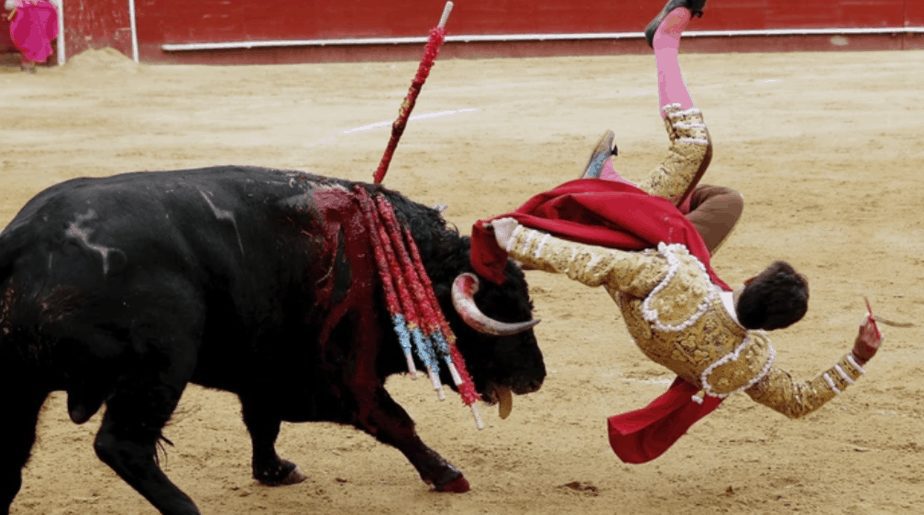The Controversial Tradition: Bullfighting in Madrid
Attending a bullfight is probably on the majority of bucket lists of the tourists of Madrid. The ancient tradition is packed with culture and history. But it’s also plagued with controversy.
The Roman adopted game is a one-on-one sport that inevitably ends in the death of the bull, unless it kills the human first. The event also involves an impressive number of bystanders who buy tickets to excitedly watch the show.
But how did this event get so popular? Are the Spanish the only ones to host the sport? And what are the facts behind the controversial debate? These are the details that are explained in this article, so that you can gain more than just entertainment from bullfighting events.
By the end of this article, you will have a solid foundation on all facts regarding bullfights, as well as a clear position on your personal opinion on the topic. Additionally, you’ll find practical details on bullfighting events at Las Ventas in Madrid.

Photo sourced from getthetruththengo.com
Origins of the Bullfighting Tradition
This sport can actually be traced back to the ancient times of gladiator games. In fact, Julius Caesar was the one to introduce into the games the fight between the bull and the matador, where the bullfighter is equipped with sword and shield.
Later, bullfighters began using the traditional red cape to encourage the bull to charge at the matador. These techniques and customs have collected and evolved to form the modern events.
Bullfighting exists today in several countries, taking place in Mexico, Columbia, Ecuador, Venezuela, Peru, southern France and Portugal, though its origins trace back mainly to Spain.
What does a bullfighting event consist of?
To better understand the bullfighting tradition, one should know what happens within the ring. The game is divided into three distinct rounds. The first is called the Tercio de Varas, and this is when the bullfighter introduces the cape.
During this first period, the matador tries to get familiar with the mannerisms of the bull to strategize the rest of the game. Following the Tercio de Varas is the Tercio de Banderillas. The word, banderillas, refers to the sharp barbed sticks that are thrown into the shoulders to anger the bull and encourage bleeding.
The third and final round is called the Tercio de Muerte, or the Third of Death. It goes without saying that this is the part of the event where the bull dies. In rare cases, the bull attacks and injures or murders the matador.
Otherwise, the bullfighter proceeds through the process of attempting to stab the bull and end the fight. At first, he uses a false sword made of alumnium or wood to move the bull into a favorable position and excite the crowd. Then, he takes up the real sword.
The bullfighter attempts to use the sword to inflict a swift death upon the bull. But sometimes, it’s not that simple. This is why there are often several real attempts to stab the bull to death. Occasionally, the president of the event will grant the bull a pardon and he will be allowed to leave alive and continue his life as a “seed-bull”, pardoned from the death of the corrida de toros for a courageous fight.
Does animal suffer?
The science behind the task of the matador is to pierce the bull in the space between his shoulders, which should lead to death within a matter of seconds. Sadly though, the bullfighters do not always take a perfect shot. The result can be that the bull actually experiences unnecessary torture and a slower death.
Of course, this doesn’t mean that every bullfighting round is a horrible scene and that every bull leaves the ring in agony. Instead, it means is that the sport may be a bit more harmless on paper than it is in practice. Therefore, the animal’s suffering slightly depends on the individual round.
In my opinion, the additional spears that are thrown into the bulls back contribute to the inhumanity of the game. These iron rods are lodged into the bulls back to enrage it. They are structured to remain in their back and also serve to cause the bull to bleed out. This is one of the more cruel elements of the sport.
Which are the major bullfighting regions in Spain?
While Madrid’s Las Ventas stadium is the most popular, it’s not the only city in Spain to host the sporting event. Visitors may also go to neighboring cities like Seville and Ronda to explore the tradition.
The Maestranza Bullring in Seville has been there since 1758, making it the oldest stadium in Spain. Seville is one of the top places to see the sport, as the ring is impressive and so are the matadors who come to perform here. Bullfights can be attended in Seville from April to October.
The city of Ronda is another remarkable place to visit for one who is interested in bullfighting. The Plaza de Toros de Ronda actually used to be King Phillip II’s center for horsemanship training.
Bullfighting at Las Ventas in Madrid
Las Ventas holds 25,000 people and hosts events every few days. Here, the San Isidro Bullfighting Festival takes place every June. Ticket prices vary depending on how close they are to the ring, and are more expensive if they are located in the shade.
If you are planning a trip to Las Ventas, be aware of scouters. You may be ushered quickly inside by someone who offers to sell you his previously bought tickets. The catch is that they’ll be more expensive than the box office price, but it also means that you can skip the line and head straight to the show. It could be something to consider if you are running late.
While this stadium has been entertaining guests in Madrid since 1929, a fun fact is that the show has gone on consistently, with the exception of the temporary shut down of Las Ventas throughout the Spanish Civil War, until it resumed the events in 1939.
Another interesting thing about Las Ventas is that it’s located in Salamanca, the luxurious neighborhood that’s known for restaurants and shopping and made it on our list of the top five areas in Madrid. Who would’ve thought that Madrid’s bullfighting center would be located in a metropolitan center?
Bullfighting cuisine: where to eat after the show?
The meat of bulls killed at Las Ventas are sent to restaurants like Casa Toribio, which is just down the street from Madrid’s Plaza de Toros. Here, you can find a variety of dishes prepared from the bull and served to the people.
The owner of Casa Toribio buys bull meat from around 100 bullfighting stadiums and serves his popular dishes year round. Interestingly, his successful restaurant started more than 20 years ago when he jokingly asked the matadors at Las Ventas if he could buy the meat of the fighting bull.
In Seville, there is actually an annual festival called the Fighting Bull Gastronomic Days, which is dedicated to tapas made with fighting bull meat. Two delicious plates that you can find in Seville during the festival are fighting bull croquettes, as well as Oxtail lasagna.
When we think of bullfighting events, we usually think of the fight more than what happens afterward. It’s interesting to consider that this traditional event actually leads to tasty cuisine. The local people of bullfighting cultures take the meat and cook it into everything from tacos to lasagna.
But there’s even more to analyse from the dishes that come from the corrida de toros. It’s the opinion of some that bull meat is healthier than that of beef cattle due to the fact that they are raised to be healthy and resiliant in order to perform well in the ring.
Bullfighting in Mexico
Mexico City has some of the largest bullfighting stadiums. La Plaza México is said to be the largest bullfighting stadium in the world to this day. La México has been running for over seventy years. Spain is the only place that hosts more bullfights per year than Mexico.
The Mexicans try not to let the bull go to waste after it’s killed, so the meat is cooked and eaten. Actually, it’s standard practice to prepare the testicles and served them in tacos.
Due to the fact that bullfighters who were less than 16 years old couldn’t fight publicly in Europe, they often moved to Mexico at a young age to continue fighting, which turned Mexico into a minor matador haven. This conflict can be attributed to the fact that, in Mexico, children can start training for bullfighting when they are as young as six years old.
What is the difference of opinion between locals and foreigners?
One of the major factors that can make bullfighting difficult to watch is the seemingly helpless position of the bull. Since the matador is constantly taunting and irritating the bull, the event begins to seem like it’s not much of a game at all.
Furthermore, additional spears are used to drain blood from the animal’s back until it’s too weak to stand and eventually dragged out of the ring. If you are passionate about animal rights, you might not want to attend the event. Seeing the fight might cause you to feel sad or even angry.
From the foreigner’s perspective, it might seem unnecessary to hold bullfights on a regular basis to someone who wasn’t born into the Spanish culture. But for the people of Spain and other countries around the world, it’s a perfectly acceptable custom.
And it’s not just tourists who find the tradition unsettling. Religious figures and even some ex-matadors have commented that the sport is horrid and unnecessary. For this reason, the sport is illegal in most countries, and is sometimes banned in the ones who typically allow it.
But how do the Spanish feel about it? Information about the treatment of the bulls can offer some insight into why Spain isn’t bothered by the event. It turns out that the matadors adhere to a strict code of conduct. Therefore, while the sport may seem gruesome, it is tailored to be respectful.
Bullfighting was done previously by royals on horseback. King Felipe V ruled this practice unfair, and thus bore the tradition of fighting on foot as it is currently done. Regulations like these make it more understandable why the Spanish see bullfights as ethical. It should be noted as well that the cultural significance might hold much more weight to the Spanish than the details.
Do women enter the bullfighting ring?

Photo sourced from madridbullfighting.com
Bullfighting is assumed to be a male sport due to the masculine display of dominance that’s associated with a matador. Nonetheless, it’s actually not at all a strictly male profession.
There are several Spanish women who are recognized for their skills in the ring. The first known lady to face a bull dates back to 1654, making at least 300 years of experience for female bullfighters.
Spain gave birth to multiple renowned female bullfighters. And as they worked their way up to success in the events, several of them also fought for gender equality and for their rights to the sport.
Among the Spanish female legacies are Christina Sánchez, Juana Cruz, Conchi Ríos, and Pajuelera, who is considered the mother of bullfighting. There is actually a film called, Habla con ella, which depicts the struggle of a woman with a passion for a traditionally male sport.
The fact that bullfighting dates back to such early times is only one factor that makes it such a debatable concept. Its impact on Spanish culture, women’s rights and other countries around the world prove that it is deeply embedded in history.
Despite the uncertainty that the intense sport can cause, it is a generally appreciated aspect of Spanish culture, and there are ethical practices in place like adhering to a code of conduct and not letting the bull meat go to waste.
Overall, a Spanish bullfight might be something that you should include on your Madrid bucket list, simply for the rich culture that it displays. Visiting the Las Ventas Plaza de Toros feels like stepping into Madrid circa 1600.
What better way is there to immerse yourself in Spain and its traditions? Bullfighting certainly gives a clearer look into what it means to be Spanish than tapas do. Whether you agree with the sport or not, it is undoubtedly a rich cultual custom of Madrid.
Planning a trip to Paris ? Get ready !
These are Amazon’s best-selling travel products that you may need for coming to Paris.
Bookstore
- The best travel book : Rick Steves – Paris 2023 – Learn more here
- Fodor’s Paris 2024 – Learn more here
Travel Gear
- Venture Pal Lightweight Backpack – Learn more here
- Samsonite Winfield 2 28″ Luggage – Learn more here
- Swig Savvy’s Stainless Steel Insulated Water Bottle – Learn more here
Check Amazon’s best-seller list for the most popular travel accessories. We sometimes read this list just to find out what new travel products people are buying.













